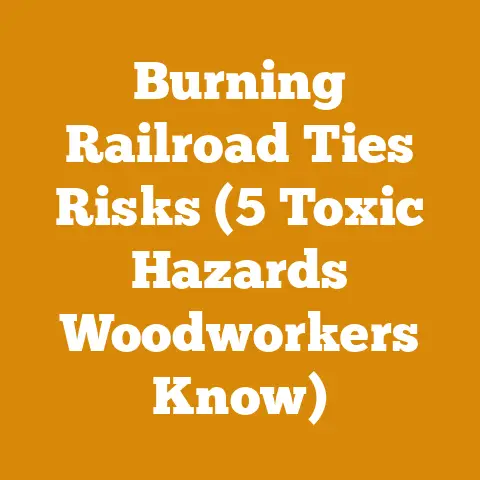Wood Pellets at TSC (5 Proven Tips for Efficient Burning)
Isn’t it ironic that we seek the warmth of a wood fire, often fueled by the modern convenience of wood pellets, yet the path to efficient burning can feel like navigating a dense forest? We want ease, consistency, and maximum heat output, but sometimes the allure of a low price tag at places like Tractor Supply Co. (TSC) can lead us astray. I’ve spent years wrestling with wood, from felling towering oaks to coaxing the perfect flame from seasoned logs. I’ve seen firsthand how the right knowledge, combined with quality fuel, can transform a frustrating fireplace experience into a cozy, efficient heat source.
In this article, I’m going to share five proven tips for efficient burning of wood pellets, specifically focusing on those you might find at TSC. We’ll dive deep into what makes a good pellet, how to store them properly, and the best burning practices to maximize heat and minimize waste. This isn’t just about saving a few bucks; it’s about respecting the resource, understanding the science behind combustion, and creating a truly sustainable heating solution. I aim to arm you with the knowledge to make informed choices, turning those TSC wood pellets into a reliable, efficient source of warmth.
Wood Pellets at TSC (5 Proven Tips for Efficient Burning)
Understanding Wood Pellets: More Than Just Sawdust
Before we even consider burning, it’s crucial to understand what we’re dealing with. Wood pellets, at their core, are a biofuel made from compressed sawdust, wood shavings, and other wood byproducts. The pressure and heat involved in the manufacturing process bind the wood fibers together, creating a dense, uniform fuel source. However, not all pellets are created equal.
Wood Anatomy and Properties:
- Hardwood vs. Softwood: Hardwood pellets (oak, maple, hickory) generally burn hotter and longer than softwood pellets (pine, fir, spruce). This is due to the higher density of hardwoods. Think of it like this: a hardwood log is packed with more potential energy per cubic inch than a softwood log. However, softwood pellets tend to ignite more easily.
- Lignin Content: Lignin is a complex polymer that acts as a natural glue in wood. Higher lignin content translates to better binding during pellet manufacturing and potentially higher heat output.
- Ash Content: This is a critical factor. Ash is the non-combustible residue left after burning. Lower ash content means less frequent cleaning of your stove or fireplace insert and potentially more efficient combustion.
TSC Pellet Quality:
TSC typically carries a range of wood pellet brands, often sourced from different manufacturers. The quality can vary depending on the supplier, the wood species used, and the manufacturing process. I’ve found that reading customer reviews is invaluable. Look for patterns in the feedback. Are people complaining about excessive ash, clinkers (hard, fused ash deposits), or inconsistent heat output? These are red flags.
Data Point: According to the Pellet Fuels Institute (PFI), premium-grade wood pellets should have an ash content of 1% or less. Standard-grade pellets can have up to 3% ash. Knowing this benchmark helps you evaluate the quality of the pellets you’re considering.
My Experience: I once bought several bags of what I thought were a great deal on wood pellets from TSC. The price was tempting, but the performance was abysmal. The pellets produced so much ash that I had to clean my stove every day. The heat output was also noticeably lower. I learned my lesson: cheap isn’t always better.
Tip #1: The “Bag Test” – Assessing Pellet Quality Before You Buy
Don’t just grab the cheapest bag on the pallet. Take a closer look. The “Bag Test” is a simple, yet effective, way to assess pellet quality before you commit to buying a large quantity.
The Visual Inspection:
- Color and Consistency: Look for pellets that are uniform in color and size. A consistent color indicates a consistent wood source and manufacturing process. Avoid bags with a lot of broken or crushed pellets (fines).
- Fines (Dust): A small amount of dust is normal, but excessive fines suggest the pellets are poorly manufactured or have been mishandled. Too many fines can clog your stove’s auger and reduce combustion efficiency.
- Foreign Objects: Inspect the bag for any visible contaminants, such as metal shavings, plastic, or other debris. These can damage your stove and release harmful emissions.
The “Shake Test”:
Gently shake the bag. You should hear a solid, dense sound. A rattling sound suggests a high percentage of broken pellets.
The “Smell Test”:
Open the bag and take a whiff. The pellets should have a clean, woody aroma. A musty or moldy smell indicates moisture contamination, which will significantly reduce their heating value.
Data Point: Studies have shown that pellets with a moisture content above 10% can experience a 20% reduction in heat output.
Real-World Example: I was helping a friend set up his new pellet stove. He’d bought several bags of pellets from TSC, and they looked okay at first glance. However, when we opened one of the bags, we noticed a distinct musty smell. Upon closer inspection, we found that the bottom of the bag was damp. The pellets had been exposed to moisture during storage. We returned the entire batch and got a fresh supply.
Tip #2: Storage is King – Protecting Your Investment
Even the highest-quality wood pellets will perform poorly if they’re not stored properly. Moisture is the enemy. Wood pellets are highly absorbent, and once they get wet, they swell, crumble, and lose their heating value.
Ideal Storage Conditions:
- Dry and Covered: Store your wood pellets in a dry, well-ventilated area, away from direct sunlight and rain. A garage, shed, or covered porch is ideal.
- Elevated: Place the bags on pallets or wooden planks to keep them off the ground and prevent moisture from wicking up from the concrete.
- Airtight Containers: For long-term storage, consider transferring the pellets to airtight containers, such as plastic bins or metal drums. This will provide an extra layer of protection against moisture and pests.
Dealing with Damaged Bags:
If you find a bag of pellets that’s been damaged or exposed to moisture, don’t use it. Discard it properly. Burning wet pellets is not only inefficient but can also damage your stove and release harmful emissions.
My Personal Story: I once made the mistake of storing a pallet of wood pellets in my shed without properly covering them. A heavy rainstorm caught me off guard, and the top layer of bags got soaked. The pellets turned into a soggy mess. I learned my lesson the hard way: proper storage is non-negotiable.
Data Point: According to the U.S. Department of Energy, improperly stored wood pellets can lose up to 50% of their heating value in just a few months.
Tip #3: Mastering Your Stove – Optimizing Burn Settings
Every pellet stove is different, and the optimal burn settings will vary depending on the model, the type of pellets you’re using, and the desired heat output. Experimentation is key.
Understanding Your Stove’s Controls:
- Feed Rate: This controls the amount of pellets that are fed into the burn pot. A higher feed rate will result in a hotter fire, but it will also consume more pellets.
- Airflow: This controls the amount of air that’s supplied to the combustion chamber. Proper airflow is essential for efficient burning and minimizing smoke.
- Temperature Setting: This sets the desired room temperature. The stove will automatically adjust the feed rate and airflow to maintain the set temperature.
Finding the Sweet Spot:
Start with the manufacturer’s recommended settings for the type of pellets you’re using. Then, make small adjustments to the feed rate and airflow until you find the sweet spot where the pellets are burning cleanly and efficiently, producing a steady, even flame.
Signs of Inefficient Burning:
- Excessive Smoke: This indicates that the pellets are not burning completely. Increase the airflow.
- Clinkers: These are hard, fused ash deposits that form in the burn pot. They indicate incomplete combustion. Try using a higher-quality pellet or adjusting the airflow.
- Low Heat Output: This could be due to a low feed rate, poor pellet quality, or a dirty stove.
Case Study: I was helping a friend troubleshoot his pellet stove. He was complaining that it wasn’t producing enough heat. After examining the stove, I noticed that the airflow was set too low. The pellets were smoldering instead of burning cleanly. I increased the airflow, and the stove immediately started producing more heat.
Data Point: A properly adjusted pellet stove can achieve a combustion efficiency of 80% or higher.
Tip #4: Regular Maintenance – Keeping Your Stove in Peak Condition
A clean stove is an efficient stove. Regular maintenance is essential for optimal performance, safety, and longevity.
Cleaning Schedule:
- Daily: Empty the ash pot.
- Weekly: Clean the burn pot, heat exchanger, and exhaust vent.
- Monthly: Inspect the auger and clean the hopper.
- Annually: Have your stove professionally inspected and cleaned.
Tools and Supplies:
- Ash Vacuum: A specialized vacuum designed for removing ash.
- Brush: A stiff-bristled brush for cleaning the burn pot and heat exchanger.
- Scraper: A metal scraper for removing stubborn ash deposits.
- Pellet Stove Cleaner: A specialized cleaner for removing creosote buildup.
Why Maintenance Matters:
- Improved Efficiency: A clean stove burns more efficiently, producing more heat with less fuel.
- Reduced Emissions: A clean stove produces fewer emissions, making it more environmentally friendly.
- Increased Safety: A clean stove is less likely to experience malfunctions or fires.
- Extended Lifespan: Regular maintenance can significantly extend the lifespan of your stove.
My Experience: I neglected to clean my pellet stove regularly one winter. The ash buildup became so severe that the stove started to malfunction. The auger jammed, and the stove shut down completely. I had to call a repair technician to fix it. The repair cost me several hundred dollars. I learned my lesson: regular maintenance is a small price to pay for peace of mind.
Data Point: Studies have shown that a dirty pellet stove can experience a 25% reduction in efficiency.
Tip #5: Strategic Purchasing – Timing is Everything
The price of wood pellets can fluctuate throughout the year, depending on supply and demand. Strategic purchasing can save you a significant amount of money.
Off-Season Buying:
The best time to buy wood pellets is typically in the spring or summer, when demand is low. Retailers often offer discounts to clear out their inventory before the next heating season.
Bulk Discounts:
Consider buying wood pellets in bulk, either by the ton or by the pallet. Many retailers offer discounts for large purchases.
Price Comparison:
Shop around and compare prices from different retailers, including TSC, local hardware stores, and online suppliers.
Monitoring Sales and Promotions:
Keep an eye out for sales and promotions. Sign up for email newsletters from your favorite retailers to stay informed about upcoming deals.
My Strategy: I always buy my wood pellets in the spring, when prices are at their lowest. I buy enough to last me through the entire heating season. This saves me a significant amount of money compared to buying pellets on an as-needed basis during the winter.
Data Point: Wood pellet prices can vary by as much as 30% depending on the time of year and the retailer.
Additional Considerations:
- Delivery Fees: Factor in delivery fees when comparing prices from different retailers.
- Storage Capacity: Make sure you have enough storage space to accommodate a large purchase.
- Pellet Quality: Don’t sacrifice quality for price. Choose pellets that meet your stove’s requirements and have a good reputation for performance.
By following these five proven tips, you can maximize the efficiency of your wood pellet burning experience, even when using pellets from TSC. Remember, it’s not just about the price of the pellets; it’s about the overall value you get in terms of heat output, convenience, and environmental impact.
Diving Deeper: The Science of Wood Pellet Combustion
To truly master the art of wood pellet burning, it’s helpful to understand the science behind it. Combustion is a complex chemical process that involves the rapid oxidation of fuel, releasing heat and light. In the case of wood pellets, the fuel is the wood itself, and the oxidant is oxygen from the air.
The Combustion Process:
The combustion of wood pellets typically occurs in three stages:
- Drying: As the pellets are heated, any moisture present evaporates. This process consumes energy and reduces the overall efficiency of combustion.
- Pyrolysis: As the temperature rises further, the wood begins to decompose, releasing volatile gases such as methane, hydrogen, and carbon monoxide. These gases are highly flammable and contribute significantly to the heat output.
- Char Burning: After the volatile gases have been released, the remaining solid residue, known as char, burns slowly, producing a steady, even heat.
Factors Affecting Combustion Efficiency:
Several factors can affect the efficiency of wood pellet combustion:
- Moisture Content: As mentioned earlier, moisture is the enemy. Wet pellets require more energy to dry, reducing the amount of energy available for pyrolysis and char burning.
- Airflow: Proper airflow is essential for supplying enough oxygen to the combustion chamber. Too little air will result in incomplete combustion, producing smoke and reducing heat output. Too much air will cool the combustion chamber, also reducing efficiency.
- Temperature: The combustion chamber must be hot enough to sustain the combustion process. If the temperature is too low, the volatile gases will not ignite properly, resulting in smoke and incomplete combustion.
- Pellet Density: Denser pellets generally burn longer and hotter than less dense pellets.
- Ash Content: High ash content can interfere with the combustion process, reducing efficiency and increasing the need for cleaning.
Optimizing Combustion:
To optimize combustion efficiency, it’s important to:
- Use dry, high-quality pellets.
- Adjust the airflow to provide the proper amount of oxygen.
- Maintain a consistent temperature in the combustion chamber.
- Clean your stove regularly to remove ash and other debris.
Beyond the Basics: Advanced Techniques for Wood Pellet Burning
Once you’ve mastered the fundamentals of wood pellet burning, you can explore some advanced techniques to further improve efficiency and convenience.
Automatic Ignition:
Some pellet stoves are equipped with automatic ignition systems, which use an electric heating element to ignite the pellets. This eliminates the need to manually light the stove, making it more convenient.
Thermostatic Control:
Many pellet stoves have thermostatic controls, which allow you to set the desired room temperature. The stove will automatically adjust the feed rate and airflow to maintain the set temperature, providing consistent, comfortable heat.
Programmable Timers:
Some pellet stoves have programmable timers, which allow you to schedule the stove to turn on and off at specific times. This can be useful for preheating your home before you arrive or for saving energy when you’re away.
Remote Control:
Some pellet stoves can be controlled remotely using a smartphone app or a remote control. This allows you to adjust the temperature, feed rate, and airflow from anywhere in your home.
Smart Home Integration:
Some pellet stoves can be integrated with smart home systems, such as Amazon Alexa or Google Home. This allows you to control the stove using voice commands.
Advanced Combustion Technologies:
Some pellet stoves incorporate advanced combustion technologies, such as secondary combustion chambers or catalytic converters, to further reduce emissions and improve efficiency.
The Future of Wood Pellet Burning
Wood pellet burning is a sustainable and efficient heating solution that is likely to become even more popular in the future. As concerns about climate change and energy security grow, more and more people are turning to renewable energy sources like wood pellets.
Emerging Trends:
- Increased Use of Biomass: The use of biomass, including wood pellets, is expected to increase significantly in the coming years.
- Development of New Pellet Stove Technologies: Manufacturers are constantly developing new pellet stove technologies that are more efficient, cleaner, and more convenient.
- Expansion of the Pellet Fuel Industry: The pellet fuel industry is expanding rapidly, with new manufacturers and distributors entering the market.
- Government Incentives: Many governments are offering incentives, such as tax credits and rebates, to encourage the use of renewable energy sources like wood pellets.
Challenges and Opportunities:
The wood pellet industry faces several challenges, including:
- Ensuring Sustainable Harvesting Practices: It’s important to ensure that wood pellets are made from sustainably harvested wood to avoid deforestation and other environmental problems.
- Reducing Emissions: While wood pellets are a relatively clean-burning fuel, they still produce some emissions. Efforts are underway to develop technologies to further reduce emissions.
- Improving Pellet Quality: The quality of wood pellets can vary significantly depending on the manufacturer. Efforts are underway to establish industry standards to ensure consistent quality.
- Educating Consumers: Many consumers are not familiar with wood pellet burning. Education is needed to inform consumers about the benefits of wood pellets and how to use them properly.
Despite these challenges, the wood pellet industry has a bright future. With continued innovation and investment, wood pellets can play a significant role in meeting the world’s energy needs while reducing greenhouse gas emissions.
Conclusion: Embracing the Warmth, Responsibly
Burning wood pellets, especially those sourced from places like TSC, can be a rewarding and efficient way to heat your home. However, it requires a commitment to understanding the fuel, your stove, and the science behind combustion. By following the five proven tips I’ve shared – the Bag Test, proper storage, mastering your stove settings, regular maintenance, and strategic purchasing – you can maximize the heat output, minimize waste, and enjoy a cozy, sustainable heating solution.
Remember, choosing the right pellets is only half the battle. How you store them, how you operate your stove, and how diligently you maintain it all contribute to the overall efficiency and enjoyment of your wood pellet burning experience. It’s a journey of learning and refinement, but the warmth and satisfaction are well worth the effort.
Next Steps:
- Implement the Bag Test: Next time you’re at TSC, put the Bag Test into practice. Compare different brands and choose the best quality pellets you can find.
- Assess Your Storage: Evaluate your current storage situation and make improvements as needed. Ensure your pellets are protected from moisture.
- Experiment with Your Stove Settings: Spend some time fine-tuning your stove’s settings to optimize combustion efficiency.
- Create a Maintenance Schedule: Develop a regular maintenance schedule and stick to it.
- Monitor Prices and Buy Strategically: Keep an eye on pellet prices and buy in bulk during the off-season to save money.
By taking these steps, you’ll be well on your way to becoming a wood pellet burning expert, enjoying the warmth and comfort of a sustainable heating solution for years to come. And who knows, maybe you’ll even inspire others to embrace the warmth, responsibly.






